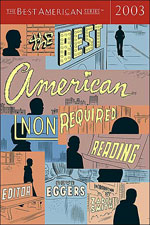[Transcribed discussion of “The Tiger’s Wife,” by Téa Obreht, published in the New Yorker.
In this story, a tiger escapes a zoo in an eastern European city that’s being bombed during World War II. Bewildered, the tiger wanders until settling in a forest outside a provincial village. In the village lives a butcher married to a deaf-mute woman. The woman begins a mysterious, secret relationship with the tiger in her husband’s smokehouse. The villagers learn that the tiger has been creeping down to the smokehouse at night, though they don’t know what the butcher’s wife’s involvement is. The butcher leads a party of three men and two dogs to hunt down the tiger. The hunt is not successful – but the butcher finds some of his meat by where the tiger was spotted resting. The butcher is enraged when he realizes his wife has been feeding the tiger his meat. He beats her and ties her up in the smokehouse. After that no one’s really sure what happens. The butcher disappears, never to be heard from again. According to legend, the butcher’s wife escaped, killed her husband, and fed him to the tiger.]
Tenaya: This story was great because it just has so much stuff in it. It’s got so many layers. There are so many characters and themes.
Nick: I thought it was good, too. I like the imagery. The way the author described the smells and the mountains. And I like the changes in perspective from the tiger to the villagers to the butcher.
Dee: I wanted to keep reading this. I couldn’t put it down. It was weird, but it was really good and I couldn’t stop reading it.
Molly D: At first, I didn’t like it. But it grew on me. I liked that you didn’t really know what happened at the end. I think she probably killed her husband, or the tiger came and got him, or something. It was a good way to end the story, to leave it open-ended.
Will: What I liked about it was the way the story kept evolving and changing. I agree with Molly, the ambiguity at the end was a good move. The author leaves a lot to our imaginations. That ambiguity is satisfying.
Paolo: That’s what I enjoyed the most about it, too. And the way you get all these fragments and then you have to piece them together. I like stories like that. This story is dreamy, and it was fun to read. I like this line a lot: “People must have seen him, but in the wake of the bombardment he was anything but a tiger to them: a joke, an insanity, a religious hallucination.”
[The students were asked if they saw the ending coming.]
Marley: No. I’ve heard of this kind of story before, though. About a wild animal outside a village, scaring the villagers. But even though I feel like this is a familiar kind of story, I didn’t feel like the ending in this case was at all predictable.
Paolo: The crazy thing was the way the author sort of made you think the butcher’s wife might have become part-tiger. That wasn’t something I was expecting. I liked that twist.
Subscribe to:
Post Comments (Atom)









No comments:
Post a Comment